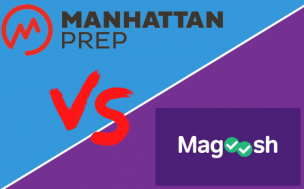If you wish to attend business school, you must now face the GMAT. You've sat so many exams in your past that you must be an expert by now, right? What could be so different about this test?
As it turns out, quite a bit! The GMAT rewards those who recognize and prepare for these differences:
1. The GMAT is a computer exam
We are undoubtedly used to scribbling answers in blue books, bubbling answer sheets and jotting notes in the margins of test booklets. However, the GMAT is one of just a handful of exams that is taken on a computer, which means your test-taking methods are affected.
Scratch paper management takes on an increased importance and should be practiced. You will only be able to use the given scratch paper during the exam. This means you have to redraw all mathematics diagrams if you wish to work with them.
You also have to repeatedly write the letters A-E if you desire the ability to cross out wrong answer choices as you eliminate them. You may have to jot down an outline for the extended reading comprehension passages, as you cannot underline important items.
2. The GMAT is adaptive
This test continually adapts as you are completing it. Correct answers lead to harder questions, and incorrect answers lead to easier questions. By the second half of each section, the test-makers believe they will have honed in on your score, and ideally you'll be getting one right, then one wrong, and so forth.
This can have enormous implications for those individuals used to taking traditional pencil-and-paper tests. For instance, you must answer the questions in the order presented. You can't move freely in each section, and you can't skip questions. You have to answer with something.
This means that the ability to quickly identify tested concepts and apply appropriate solving-methods is crucial. In addition, strategic guessing now becomes a necessity, instead of a luxury – instead of possessing the option to guess for additional points, you may be required to guess to continue the test.
3. The GMAT wants to know what you think – about how others think
On other exams you've sat for, especially in reading comprehension sections, you may have been asked about an author's point of view or about how an author structures a passage.
Additionally, you've probably been prompted to write essays requiring your own opinions on a certain topic. On the GMAT, however, your essay will be an analysis of an argument someone else has made – an argument that is necessarily flawed, but someone else's argument nonetheless.
In the Verbal section, in addition to the aforementioned reading comprehension questions, the GMAT includes critical reasoning problems - the majority of which require you to analyze the assumptions made in brief arguments or situations.
This test is less concerned with your opinion and more interested in how you analyze how others form theirs; a concept that is foreign to many.
4. The GMAT tests your ability to know when you have sufficient information
The GMAT features an unusual type of question: data sufficiency. On other tests, mathematics sections usually have several problems in which “none of the above” appears as an answer choice – but these questions are not common, so the appearance of that statement may raise red flags.
In data sufficiency situations, you have two statements that provide you with information to answer a given question, although one or both of these statements are very often not enough to answer the question being posed. Your task is to figure out what you need, what you're given, and whether you have enough – a skill that requires practice.
5. The GMAT has a new section
Test-takers used to compose two essays. Now, you'll complete one essay and spend 30 minutes on the new Integrated Reasoning section. A recent addition to the GMAT, this section comprises 12 questions that require you to analyze tables, graphs, charts and figures.
These skills are extremely useful in the business world, although many business school admissions offices are still somewhat uncertain how they will use this section's score. Nevertheless, this section promises to become more useful as it is better understood, as it provides institutions with another piece of data to evaluate applicants.
Although the GMAT is different than other exams you've taken, it does have one main similarity: it is standardized, which means you can prepare for it and do well. Do so, and the next set of letters you'll be facing will be M, B, and A!
Toby Blackwell is a professional GMAT tutor and contributing writer for Varsity Tutors. He graduated with honors and received his Bachelor’s degree from Harvard University. He scored a 770 on the GMAT.
RECAPTHA :
5c
ba
fa
59



 78
78 



Comments.